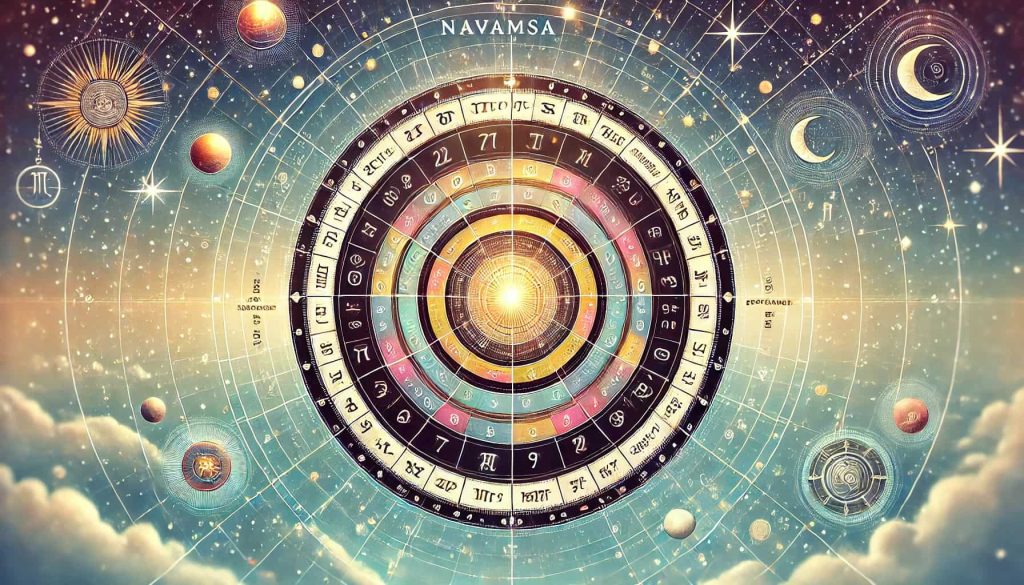Everything You Need to Know about the Navamsa Chart
Aryan K | October 4, 2024

- Understanding the Navamsa Chart
- How is the Navamsa Chart Calculated?
- Relationship with the Birth Chart and Rashi Chart
- Why is the Navamsa Chart Important in Vedic Astrology?
- How to Perform Navamsa Chart Reading
- Detailed House Significations in the Navamsa Chart
- Remedies for Challenging Navamsa Placements and Malefic Planets
- Conclusion: Navamsa Chart and Deluxe Astrology
The Navamsa chart also called the D9 chart, is one of the most crucial divisional charts in Vedic astrology. It reveals deeper insights about a person’s life, especially concerning marriage, relationships, spiritual growth, and karmic patterns. The word Navamsa translates to “nine divisions” in Sanskrit, reflecting how each zodiac sign is divided into nine parts. While your birth chart (Rasi chart) gives a broader view of your life, the Navamsa chart offers a more detailed interpretation, focusing on hidden potentials and spiritual evolution.
The condition of the Navamsa Lagna in the Navamsa chart is a strong indicator of fortune and planetary strength. It significantly influences one’s luck and capabilities, and it must not be debilitated in either the D1 (natal) chart or the D9 chart for favorable outcomes.
Contrary to popular belief, the Navamsa chart’s influence is not limited to post-marriage or middle age (32 years). It begins to affect a person’s life from birth. However, its effects may become more prominent during certain life events, such as marriage.
Understanding the Navamsa Chart
The Navamsa chart, a pivotal divisional chart in Vedic astrology, offers profound insights into various aspects of life, including relationships, career, and spiritual growth. Derived from the Sanskrit word “Navamsa,” meaning “nine divisions,” this chart divides each zodiac sign into nine equal parts, providing a more nuanced analysis of planetary strengths and weaknesses compared to the birth chart.
In Vedic astrology, the Navamsa chart is indispensable for understanding the finer details of a person’s life. It delves into the subtleties that the birth chart might not fully reveal, such as the timing of significant life events like marriage and career changes. Each of the nine sections in the Navamsa chart represents different facets of life, from self-identity and relationships to creativity and spiritual growth.
Astrologers use the Navamsa chart to assess the true potential and challenges of planetary placements. For instance, a planet that appears weak in the birth chart might show its true strength in the Navamsa chart, indicating areas where an individual can excel or face challenges. This deeper layer of analysis makes the Navamsa chart a crucial tool for anyone seeking a comprehensive understanding of their life path.
How is the Navamsa Chart Calculated?
The Navamsa chart is calculated by dividing each zodiac sign (which spans 30°) into nine equal parts, with each division being 3°20′. These divisions create a total of 108 Navamsas across the 12 zodiac signs. Each planet in the birth chart is then assigned a new position in the Navamsa chart based on its exact degree within its sign. For instance, if your Sun is positioned at 10 degrees in Aries in your birth chart, it will be repositioned within one of the nine divisions of Aries in the Navamsa chart. The positions of planets in the natal chart influence personal traits and spiritual development, and this new position provides additional insights that aren’t immediately visible in the birth chart.
Luckily, you don’t have to perform these complex calculations manually. Astrology tools like Deluxe Astrology can instantly generate your Navamsa chart and provide easy-to-understand interpretations.
Relationship with the Birth Chart and Rashi Chart
The Navamsa chart works hand-in-hand with the birth chart, also known as the Rashi chart, to provide a holistic view of a person’s life. While the Rashi chart outlines the broader trends and patterns, the Navamsa chart zooms in on the intricate details, offering a more refined analysis.
In Vedic astrology, the birth chart is the foundation, depicting the positions of planets at the time of birth and their influence on various life aspects. However, the Navamsa chart takes this analysis a step further by revealing the underlying strengths and weaknesses of these planetary positions. For example, a planet that seems weak in the birth chart might be well-placed in the Navamsa chart, indicating potential areas of growth and improvement over time.
Understanding the relationship between the Navamsa chart and the birth chart is essential for accurate predictions and insights. The Navamsa chart helps astrologers pinpoint the timing of significant events, such as marriage or career shifts, by analyzing the finer details that the birth chart might overlook. This dual analysis ensures a more comprehensive understanding of an individual’s life journey.
Moreover, the Navamsa chart is crucial for assessing the true nature of relationships and partnerships. By examining the 7th house and other relevant placements in both the birth chart and the Navamsa chart, astrologers can provide detailed insights into marital harmony, compatibility, and potential challenges.
In summary, the Navamsa chart complements the birth chart by offering a deeper, more detailed analysis of a person’s life. Together, they provide a complete picture, helping individuals navigate their life path with greater clarity and understanding.
Why is the Navamsa Chart Important in Vedic Astrology?
The Navamsa chart serves as a refined analysis of your planetary placements, offering insights into the strength of the planets, your marriage, and even karmic lessons from past lives. Navamsa chart reading is essential for understanding the true strength and potential of a horoscope. Here are the main reasons why the Navamsa chart is indispensable in astrology:
Marriage and Relationships: The Navamsa chart interpretation plays a pivotal role in understanding marriage and relationships. It focuses on the 7th house and Venus (the planet of love) to provide insights into your spouse’s nature, the dynamics of your relationship, and the overall quality of your married life. If Venus or Jupiter is well-placed in the Navamsa chart, it often signifies harmony and fulfillment in marriage.
Planetary Strengths and Weaknesses: One of the core uses of the Navamsa chart is to assess the true strength of planets. A planet that appears weak in the birth chart may still perform well if it is well-placed in the Navamsa chart. For example, if Venus is weak in your birth chart but strong in the Navamsa chart, this suggests that relationship issues early in life may improve over time.
Spiritual Growth and Karmic Lessons: The Navamsa chart is often used to evaluate a person’s spiritual development. Certain planets, such as Jupiter and Ketu, offer insights into your dharma (life purpose) and spiritual path. Additionally, Saturn, Rahu, and Ketu often reveal unresolved karmic lessons that you need to work through to lead a more fulfilling life.
Navamsa Activation: While the Navamsa chart begins influencing life from birth, many astrologers believe it becomes more active after marriage or by the age of 32. This belief arises from the idea that relationships and partnerships are key life events that activate the deeper karmic influences shown in the Navamsa chart.
How to Perform Navamsa Chart Reading
To read the Navamsa chart effectively, it’s essential to follow these steps and understand the importance of the Navamsa or D9 chart in determining timelines and conditions for marriage:
Examine Planetary Positions: Start by analyzing the placement of planets in the Navamsa chart. Planets exalted or well-placed in friendly signs will have stronger, more beneficial effects, while planets in enemy or debilitated signs may create challenges.
Check the Strength of Planets: Planets placed in their own sign, exalted sign, or friendly sign are said to be strong in the Navamsa chart, even if they are weak in the birth chart. This strength becomes evident in key life events, such as marriage.
Analyze the 7th House: The 7th house in the Navamsa chart governs marriage and partnerships. Analyze the planets present here and their aspects to get a clear picture of your relationship life. For example, a well-placed Venus suggests a harmonious marriage, while challenging aspects may indicate difficulties.
Karmic Influences: The Navamsa chart often highlights past-life karmic patterns. Planets like Saturn and the nodes (Rahu and Ketu) can reveal unresolved karmic debts that may need to be addressed in this lifetime. These insights can help you navigate the spiritual and material lessons you need to learn.
Look for Special Combinations (Yogas): Certain planetary combinations, or yogas, within the Navamsa chart can reveal blessings or challenges. For instance, when the same sign appears in both the birth chart and the Navamsa chart (Vargottama), it enhances the planet’s power and indicates a significant positive influence.
Detailed House Significations in the Navamsa Chart
Each house in the Navamsa chart governs specific areas of life. Here’s a brief explanation of the key houses:
1st House (Lagna): Represents the self, personality, and overall direction of life. The condition of the lagna lord in the Navamsa chart is crucial, as a strong and well-placed lagna lord significantly influences a person’s fortune, marriage, and overall life path.
4th House: Relates to inner peace, comfort, and domestic happiness.
7th House: Represents marriage, partnerships, and spouse compatibility.
9th House: Indicates spiritual growth, dharma (life purpose), and wisdom.
Remedies for Challenging Navamsa Placements and Malefic Planets
If certain planets are poorly placed in the Navamsa chart, remedies can help mitigate their negative effects. Analyzing the placement of malefic planets in the Navamsa chart is crucial, as their influence can affect one’s spiritual journey, financial progress, and personal relationships. Common remedies in Vedic astrology include wearing specific gemstones, reciting mantras, performing charitable acts, or conducting rituals to strengthen weak planets. Deluxe Astrology offers personalized remedies based on your Navamsa chart to help you overcome these challenges.
Conclusion: Navamsa Chart and Deluxe Astrology
The Navamsa chart is a powerful tool that provides deeper insights into marriage, spiritual growth, and karmic influences. Its role in refining the interpretations of your birth chart makes it essential for a comprehensive astrological analysis. Analyzing the Navamsa chart alongside the birth chart provides deeper insights into a person’s married life and overall fortune.
For those interested in exploring their Navamsa chart further, Deluxe Astrology offers a free and user-friendly astrology platform to generate and analyze your Navamsa chart in detail. By using Deluxe Astrology, you can access personalized remedies and gain a deeper understanding of how your planets affect key areas of life, especially marriage and spiritual evolution. Visit Deluxe Astrology today to start your astrological journey!
Sign up today
Recent Posts

September 14 Zodiac Sign: Traits and Characteristics of Virgos
Aryan K | March 31, 2025

Spirit Animal Spider Meaning: A Guide to Its Interpretation
Olivia Marie Rose | March 31, 2025

Understanding Virgo in Astrology: Traits, Compatibility, and More
Olivia Marie Rose | March 30, 2025

How to Know if You Are Manglik: A Simple Guide
Aryan K | March 30, 2025

Leo and Capricorn Compatibility: Love, Friendship, and Relationship Insights
Aryan K | March 30, 2025
Topics
- 4 Digit Angel Numbers
- 5 Digit Angel Numbers
- 6 Digit Angel Numbers
- Astrology and Birth Charts
- Business Astrology
- Career Astrology
- Celebrities and Personalities Astrological Profile
- Children Astrology
- Chinese Astrology
- Different Angel Numbers Meaning
- Double Digit Angel Numbers
- Dreams Interpretation
- Festivals
- Finance Astrology
- Find Baby Names
- Find Best Astrologers
- Gemstones and Birthstones
- Janam Kundli Chart
- Love Astrology
- Marriage Prediction Astrology
- Nakshatra (Constellations)
- Numerology
- Pet Astrology
- Rudraksha Beads
- Single Digit Angel Numbers
- Spirit Animals
- Spirituality and Positivity
- Stars, Planets and Cosmic
- Symbolism
- Tarot Cards
- Triple Digit Angel Numbers
- Understanding Hinduism
- Vastu Shastra
- Vedic Astrology
- Western Astrology
- Yoga and Meditation
- Zodiac Sign Date Calendar
- Zodiac Signs
- Zodiac Signs Compatibility
